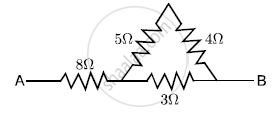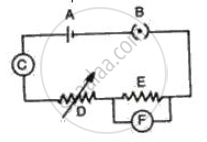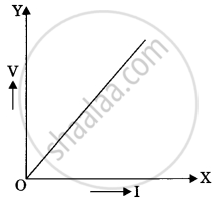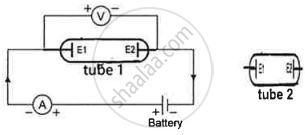Advertisements
Advertisements
प्रश्न
Define Current density.
उत्तर
Current density is a vector quantity, often known as an area vector or cross-sectional area vector, whose value is equal to the electric current flowing per unit area.
J = `"I"/"A"`
S.I unit is A/m2.
APPEARS IN
संबंधित प्रश्न
Four resistances of 16 ohms each are connected in parallel. Four such combinations are connected in series. What is the total resistance?
In a conductor 6.25 × `10^16` electrons flow from its end A to B in 2 s. Find the current flowing through the conductor (e = 1.6 × `10^-19` C)
An electric bulb draws 1.2 A current at 6.0 V. Find the resistance of filament of bulb while glowing.
Show by a diagram how two resistors R1 and R2 are joined in parallel. Obtain an expression for the total resistance of the combination.
Calculate the effective resistance across AB?

Fig. represents the circuit used for the verification of ohm's law. Label the different parts from A and F. State the function of each.

State the relation correlating the electric current flowing in a conductor and the voltage applied across it. Also, draw a graph to show this. relationship.
What are non-ohmic conductors? Give one exmaple. Draw a current-voltage graph for a non-ohmic conductor.
State Ohm’s law.
A wire connected to a power supply of 230 V has power dissipation P1. Suppose the wire is cut into two equal pieces and connected parallel to the same power supply. In this case, power dissipation is P2. The ratio of `"P"_2/"P"_1` is
Obtain the macroscopic form of Ohm’s law from its microscopic form and discuss its limitation.
The resistance of a nichrome wire at 0°C is 10Ω. If its temperature coefficient of resistivity of nichrome is 0.004/ °C, find its resistance of the wire at boiling point of water. Comment on the result.
The slope of voltage (V) versus current (I) is called:

The temperature of a conductor is increased. The graph best showing the variation of its resistance is:
Assertion: The statement of Ohm’s law is K = IR.
Reason: V = IR is the equation which defines resistance.
The heat produced by a 100 w heater in 2 minute is equal to
You are provided with a resistor, a key, an ammeter, a voltmeter, four cells of 1.5 V each and few connecting wires. Using circuit components, draw a labelled circuit diagram to show the setup to study Ohm's law.
State the relationship between potential difference (V) across the resistor and the current (I) flowing through it. Also draw V-I graph, taking V on the X-axis.
Why should an ammeter have low resistance?
The circuit depicted in the figure is employed for studying Ohm's Law. Instead of using a standard resistor, a student opts for a glass tube filled with mercury (tube 1), connected to the circuit through two electrodes E1 & E2. He records the readings of the ammeter and voltmeter, thereby calculating the resistance. The student repeats the experiment by substituting tube 1 with tube 2, where the same amount of mercury fills the tube 2.

Neglecting internal resistance of the cell use (> or < or =) to compare
- the resistance in both the cases.
- the voltmeter readings in both the cases.
- the specific resistance in both the cases.
